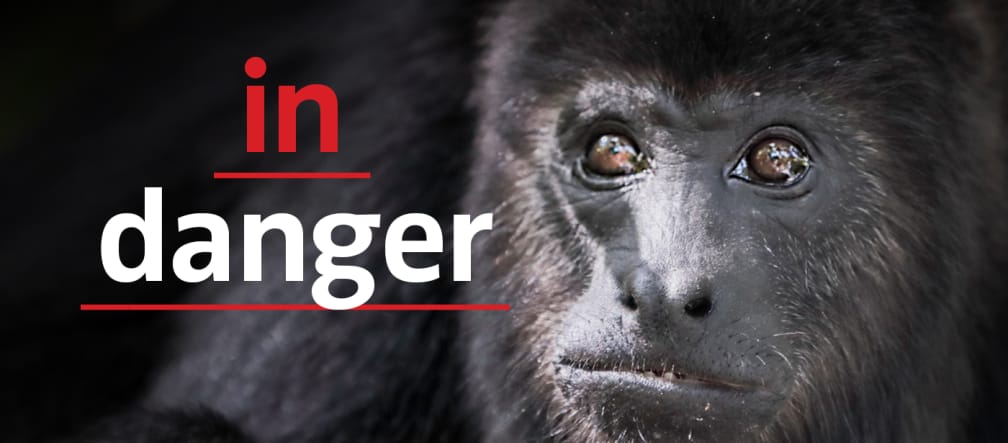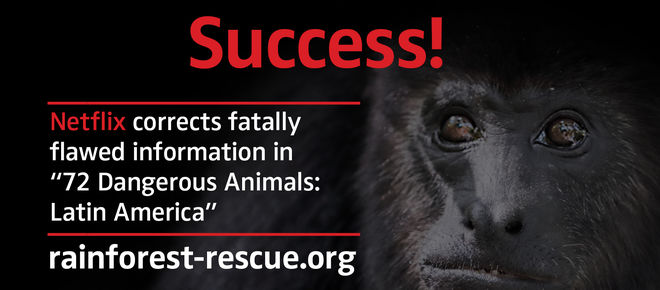
Completed campaign
Netflix: stop threatening the lives of howler monkeys!
Netflix’s series “72 Dangerous Animals: Latin America” falsely claims that howler monkeys transmit yellow fever to humans. This myth has long led to the wholesale slaughter of monkeys by misinformed people. With this series, Netflix is destroying the efforts of awareness campaigns and threatening the conservation of primates.
News and updatesTo: Netflix Chief Content Officer Mr. Ted Sarandos
“Netflix must stop streaming the 7th episode of the series “72 Dangerous Animals: Latin America” worldwide.”Yellow fever is a deadly disease transmitted by mosquitoes.
It is commonly believed that howler monkeys are reservoirs of yellow fever and transmit it to humans, but this is WRONG. Howler monkeys mostly die of it in a matter of days, and when they don’t, they develop immunity. Thus, they are not reservoirs of the disease – on the contrary, they play an important role as sentinels: howler monkeys are a “canary in the coalmine”, with dead animals providing an early warning to local health authorities, alerting them to the presence of the disease. Furthermore, only mosquitoes are capable of transmitting the disease to humans.
These falsehoods regarding the role of the monkeys, conveyed by the media, spread quickly among the population during the 2007-2009 yellow fever outbreak in Brazil, and people afraid of contracting the disease went on a rampage, killing howler monkeys.
Some howler monkey species are listed as threatened by the IUCN, and considering their role as yellow fever sentinels, it is crucial for human health that we protect them. The campaign “Protect our Guardian Angels”, launched in 2009, promotes vaccination and raises awareness of the howler monkeys’ value in protecting humans against the disease.
The 7th episode of the new Netflix series “72 Dangerous Animals: Latin America,” launched on the 22nd of December 2017, claims that howler monkeys transmit yellow fever to humans. This flies in the face of a massive campaign to raise awareness of the true nature of yellow fever. People often trust the media more than scientific studies, exposing monkeys to the threat of further wholesale killings. We call on Netflix stop streaming this sensationalist and flawed episode.
More than 60 scientists from a range of international institutions support our petition to Netflix:
- Júlio César Bicca-Marques, Pontifícia Universidade Católica do Rio Grande do Sul, Brazil
- Cláudia Calegaro-Marques, Universidade Federal do Rio Grande do Sul, Brazil
- Óscar M. Chaves, Pontifícia Universidade Católica do Rio Grande do Sul, Brazil
- Paul A. Garber, University of Illinois at Urbana-Champaign, USA
- Russell A. Mittermeier, Primate Specialist Group/ International Union for Conservation of Nature, USA
- Anthony B. Rylands, Primate Specialist Group/ International Union for Conservation of Nature, USA
- Karen B. Strier, University of Wisconsin-Madison, USA
- Alejandro Estrada, National Autonomous University of Mexico, Mexico
- Janette Wallis, University of Oklahoma, USA
- Colin A. Chapman, McGill University, Canada
- Michael A. Huffman, Kyoto University Primate Research Institute, Japan
- Nancy G. Caine, California State University San Marcos, USA
- Marco A. B. de Almeida, Centro Estadual de Vigilância em Saúde/RS, Brazil
- Alessandro Pecego Martins Romano, Universidade de Brasília, Brazil
- Márcio Port-Carvalho, Instituto Florestal, Brazil
- Eduardo B. Ottoni, Universidade de São Paulo, Brazil
- Patrícia Izar, Universidade de SãoPaulo, Brazil
- Martin Kowalewski, National Scientific and Technical Research Council, Argentina
- Mariana Raño, National Scientific and Technical Research Council, Argentina
- Leonardo de C. Oliveira, Universidade do Estado do Rio de Janeiro, Brazil
- Vanessa B. Fortes, Universidade Federal de Santa Maria, Brazil
- Ítalo Mourthé, Universidade Federal do Pará, Brazil
- Mélissa Berthet, University of Neuchâtel, Switzerland
- Fabiano R. de Melo, Universidade Federal de Viçosa, Brazil
- Sarie Van Belle, University of Texas in Austin, USA
- Stacey Tecot, University of Arizona, USA
- Paulo Henrique Gomes de Castro, Centro Nacional de Primatas, Brazil
- Waldney Pereira Martins, Universidade Estadual de Montes Claros, Brazil
- Cecília Kierulff, Universidade Federal do Espírito Santo, Brazil
- Eleonore Z. F. Setz, Universidade Estadual de Campinas, Brazil
- Julio Cesar de Souza Jr., Fundação Universidade Regional de Blumenau, Brazil
- Cristiane Cäsar, Pontifícia Universidade Católica de Minas Gerais, Brazil
- Marcia Maria de Assis Jardim, Fundação Zoobotânica do Rio Grande do Sul, Brazil
- Fernanda Pozzan Paim, Instituto de Desenvolvimento Sustentável Mamirauá, Brazil
- Sergio Lucena Mendes, Universidade Federal do Espírito Santo, Brazil
- Elisandro Oliveira dos Santos, Universidade Luterana do Brasil, Brazil
- Julie Wieczkowski, State University of New York at Buffalo, USA
- Guillaume Dezecache, Institut Jean Nicod, France
- Thais Leiroz Codenotti, Associação para a Conservação da Vida Silvestre, Brazil
- Michelle A. Rodrigues, University of Illinois at Urbana-Champaign, USA
- Gilza Maria de Souza Franco, Universidade Federal da Fronteira Sul, Brazil
- Eliara Solange Müller, Universidade Comunitária da Região de Chapecó, Brazil
- Helena P. Romanowski, Universidade Federal do Rio Grande do Sul, Brazil
- Clarice B. Fialho, Universidade Federal do Rio Grande do Sul, Brazil
- Liliana Essi, Universidade Federal de Santa Maria, Brazil
- Fabíola Dalmolin, Universidade Federal da Fronteira Sul, Brazil
- Lucas Krüger Garcia, Universidade Comunitária da Região de Chapecó, Brazil
- Maria Elisabeth Kleba, Universidade Comunitária da Região de Chapecó, Brazil
- Anna Maria Siebel, Universidade Comunitária da Região de Chapecó, Brazil
- Felipe Klein Ricachenevsky, Universidade Federal de Santa Maria, Brazil
- Yaëlle Bouquet, Université de Neuchâtel, Switzerland
- Geraldo Ceni Coelho, Universidade Federal da Fronteira Sul, Brazil
- Mariana Labão Catapani, Universidade de São Paulo, Brazil
- Daniel Galiano, Universidade Federal da Fronteira Sul, Brazil
- José Julián León Ortega, Université de Neuchâtel, Switzerland
- Gerson Paulino Lopes, Universidade Federal do Amazonas, Brazil
- Mariana Nagy Baldy dos Reis, University of Alberta, Canada
- Margarita Briseño Jaramillo, Instituto Politecnico Nacional, Mexico
- Rogério Grassetto Teixeira da Cunha, Universidade Federal de Alfenas, Brazil
- Renata G. Ferreira, Universidade Federal do Rio Grande do Norte, Brazil
- Maria Adélia Borstelmann de Oliveira, Universidade Federal Rural de Pernambuco, Brazil
An open letter to Netflix by the International Primatological Society
Further information
New York Times: Brazil Yellow Fever Outbreak Spawns Alert: Stop Killing the Monkeys
Articles in French on yellow fever and howler monkeys:
Reporterre: Victimes de la fièvre jaune, les singes meurent par milliers au Brésil
Passport Health: Les singes hurleurs ont sonné l’alarme de l’épidémie de fièvre jaune au Brésil
Facebook page of the Protect our Guardian Angels campaign (in Portuguese)
To: Netflix Chief Content Officer Mr. Ted Sarandos
Dear Mr. Sarandos,
Since the 22nd of December 2017, Netflix has been streaming a new series by Showrunner Productions entitled “72 Dangerous Animals: Latin America”. The 7th episode of the series claims that howler monkeys are dangerous because they can transmit yellow fever to humans.
This statement is wrong: it is well known among the scientific community that mosquitoes are vectors of the disease. The myth that howler monkeys transmit the disease to humans, largely conveyed by the media, spread quickly among the population during the 2007-2009 yellow fever outbreak of Brazil. It resulted in the pointless, widespread killing of howler monkeys by people afraid of contracting the disease.
Howler monkeys from the regions south of the Amazon are threatened with extinction according to the IUCN. Furthermore, they play an important role as yellow fever sentinels, since their death provides an early warning to health authorities of the presence of the disease and the need to vaccinate local populations. Campaigns such as “Protect our Guardian Angels” and “Celebrities against Yellow Fever,” launched in 2017 and supported by 29 educational, scientific and governmental institutions and NGOs, promote vaccination and raise awareness of the howler monkeys’ value in protecting humans against the disease.
However, people often trust major media outlets more than scientific studies. Due to its large audience, Netflix has a huge impact on people and has the responsibility to convey reliable, validated information when streaming documentaries. This episode flies in the face of the massive campaign to raise awareness of the true nature of yellow fever and protect monkeys against the threat of further wholesale killings. We call on Netflix to stop streaming this sensationalist and flawed episode worldwide and be more careful in their choice of documentaries in the future.
Yours faithfully,


